- Barre chords
- Open chords
Being able to read chord charts (aka chord diagrams) should be one of the first things you learn as a beginner guitarist. You'll find chord charts in many shapes and sizes all over the Internet, and these chord charts will help you learn new chords and songs.
These chord boxes, as some call them, can be a bit weird to the untrained eye, so let's learn how to read guitar chord charts right now.
1. The basic chord diagram
On the left, you can see what a basic chord chart will look like. Just a bunch of lines? Nope, have a look at the guitar neck on the right, see any resemblance?
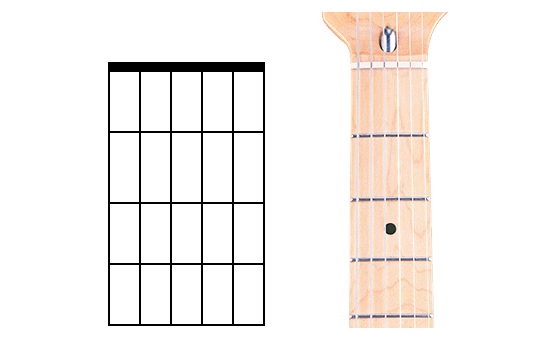
As you can see, the basic chord chart is actually a representation of the guitar neck.
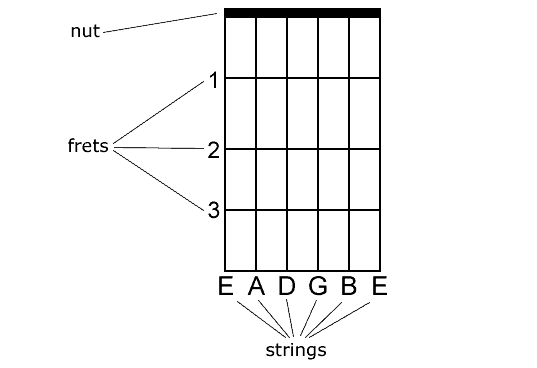
Here are the details of the individual lines:
- The top horizontal line is the nut
- The rest of the horizontal lines are frets
- The vertical lines are the strings. The low E string is always on the left, the high E string is on the right. Just as if you were looking at a guitar neck (a right-handed guitar's neck to be precise).
2. A real chord on the diagram
Now that you are familiar with the "container", let's have a look at how a chord would be displayed.
We'll use the A minor chord as an example:

There are several things you need to observe:
- Above the horizontal nut line, you'll see x and o shapes. The x means you shouldn't play the string under the symbol for the given chord, and the o means you need to play the string open.
So with the A minor, the x above the low E string indicates we shouldn't play that string at all, and the o shapes above the A and high E strings mean that we need to play those strings open. - The big filled dots smacked on the strings mean that you have to fret the given string at the fret the black dot is.
So with the A minor, we have big black dots on the D string at fret 2, on the G string at fret 2, and on the B string at fret 1. These are the notes you have to hold down.
Sometimes, the chord chart will include numbers placed on the big black dots as below.
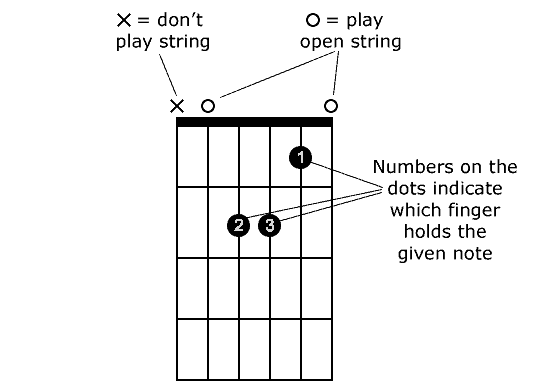
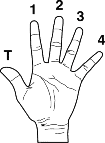
These numbers indicate which finger you should be holding down the given string with. 1 is your pointing finger, 2 is your middle finger, 3 is your ring finger, and 4 is your pinky.
Many beginners mistake these with fret numberings, but now you know better. These numbers are just helping you arrive at the correct fingering for the given chord.
3. Chord charts further up on the guitar neck
Yes, you can form chords all over the guitar neck, and there is a "special" way to indicate chord diagrams showing chords further up the neck. So by this, we mean chords that are not right at the end of the guitar neck (not by the nut). These chords will be indicated by added fret numberings.
There are actually several ways chord charts tend to display such chords, here are 2 examples of the C minor barre chord, showing the most commonly observed methods for displaying guitar chords up the neck:

- The diagram on the left indicates that the line where the nut used to be isn't the nut anymore, it's actually fret 7
- The diagram on the right shows the fret numberings for each fret.
As you can see, this can be a bit tricky, since both chord diagrams display the exact same chord, but using different fret numberings. Just keep in mind that if a number is right next to a fret line, it's indicative of that actual fret number, and if a number is in between frets, the number is indicative of the next fret line.
4. Horizontal chord charts
As I mentioned, chord charts come in all shapes and sizes. Many websites use vertical chord diagrams, but a lot of them use horizontal ones as well.
Don't let this disturb you, horizontal chord charts are the same as vertical ones, they're just turned on their side, like this example of the A minor chord we had initially:
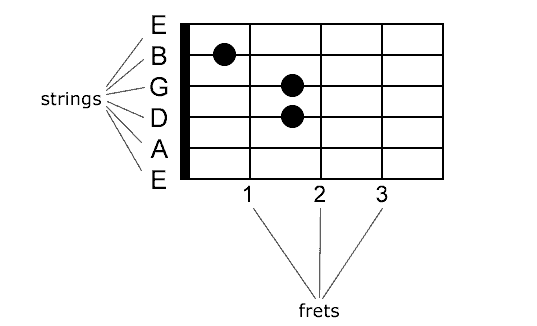
And that's pretty much everything, you should now know how to read guitar chord charts correctly. You will need to practice deciphering them a bit, but soon, you'll be able to understand them at a glance.
NEW: Chords Database
Check out our free database of guitar chords, containing chord charts and fingering diagrams to over 1,400 guitar chords.
If you want to refine the skills you learned in How to Read Guitar Chord Charts & Diagrams, check out these lessons on songs by clicking these links:
Barre chords / Open chords
Download tabs for How to Read Guitar Chord Charts & Diagrams
 Sorry, but you've reached a premium content area. The download of the How to Read Guitar Chord Charts & Diagrams tablature file is only available to premium members.
Sorry, but you've reached a premium content area. The download of the How to Read Guitar Chord Charts & Diagrams tablature file is only available to premium members.
Download backing track for How to Read Guitar Chord Charts & Diagrams
 Sorry, the same goes for the backing track. To download the backing track to How to Read Guitar Chord Charts & Diagrams, please log in and revisit this page.
Sorry, the same goes for the backing track. To download the backing track to How to Read Guitar Chord Charts & Diagrams, please log in and revisit this page.
Please log in and revisit this page to download this song's tabs and backing track (along with hundreds more on the site).

Leave a Reply